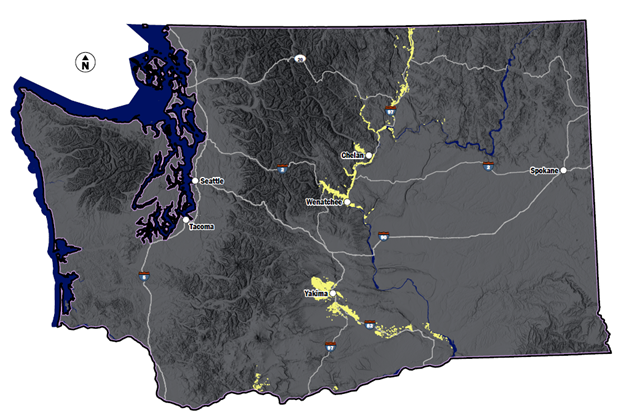In Washington state’s agricultural hubs – Wenatchee, Yakima, and Chelan – former orchard land is being redeveloped to meet housing demands. Aspect has worked on several projects that are safely turning these brownfield sites into new housing for residents.
As the Washington State Department of Ecology recently detailed, former orchard lands have a history of pesticide use, and the type of pesticides used has changed over time. Orchards that were active between 1900 and 1950 generally used lead arsenate, which left residual concentrations of both lead and arsenic in near-surface soil at concentrations above Ecology’s cleanup levels.
Example of former orchard land in East Wenatchee, where new housing now sits.
Snapshot of Former Orchard Land and Cleanup Process
Ecology has classified these former orchards with potential lead arsenate contamination and included them in their publically available ‘Dirt Alert’ program (based on historical aerial photo interpretation and other methods). As shown in the image below, orchard lands are generally concentrated in the Columbia, Yakima, Okanogan, and Wenatchee river basins throughout central Washington.
Using Ecology’s publicly available Dirt Alert mapping, see land (yellow on map) that Ecology delineated as orchard during the lead arsenic era: 1900-1950
Project Spotlight: Cleanup and 20 New Residential Homes near Chelan, WA
Aspect recently supported Chelan County to cleanly ‘cap’ the soil at a former orchard residential redevelopment in Manson near Lake Chelan for 20 new homes so it would protect human health and the environment. Chelan County Natural Resources Department used an Ecology grant to evaluate the costs associated with implementation of a Model Remedy (that is, a clean cap remedy) for this ‘trial implementation’. Aspect supported Chelan County by:
Sourcing and analytically testing clean soil cap sources
Sourcing and calculating soil amendment (compost) requirements for lawn support
Construction sequence and contractor coordination
Cost tracking
The trial found that the cost of implementing the clean soil cap model remedy amounted to approximately $5,000 per parcel.
Model Remedies Cleanup for Agricultural Owners and Developers
Model Remedies can guide property owners, developers, and consultants to clean up these lead arsenate properties efficiently and protect the community. Contamination is often limited to just the topsoil layer, thus reducing the complexity of cleanup. There are a few routes to cleanup:
Excavation and off-Site disposal is a conventional clean-up method that in most cases is too costly for a residential redevelopment.
Capping is a model remedy in which the contaminated soil remains on site and is “capped” with asphalt, building foundations, and delineated landscaping beds and is generally the most cost-effective model remedy.
Mixing is a solution where the soil column is mixed until contaminant concentrations throughout the soil layer are all below cleanup levels. A mixing model remedy could be applicable when contamination is limited to a very shallow depth.
Capping is the most commonly used cleanup method in the Model Remedy process. Capping keeps residential communities safe by providing a physical barrier (such as asphalt or colored demarcation fabric beneath the topsoil) between residents and the contaminated soil. Lead arsenate is generally contained within the near-surface soil, so there is no exposure risk related to drinking water or using groundwater. Also, because metals do not vaporize, there is not a threat of vapor intrusion into structures.
Contact Aspect’s Breeyn Greer and Adam Griffin for more information about the cleanup process for orchard redevelopment.






